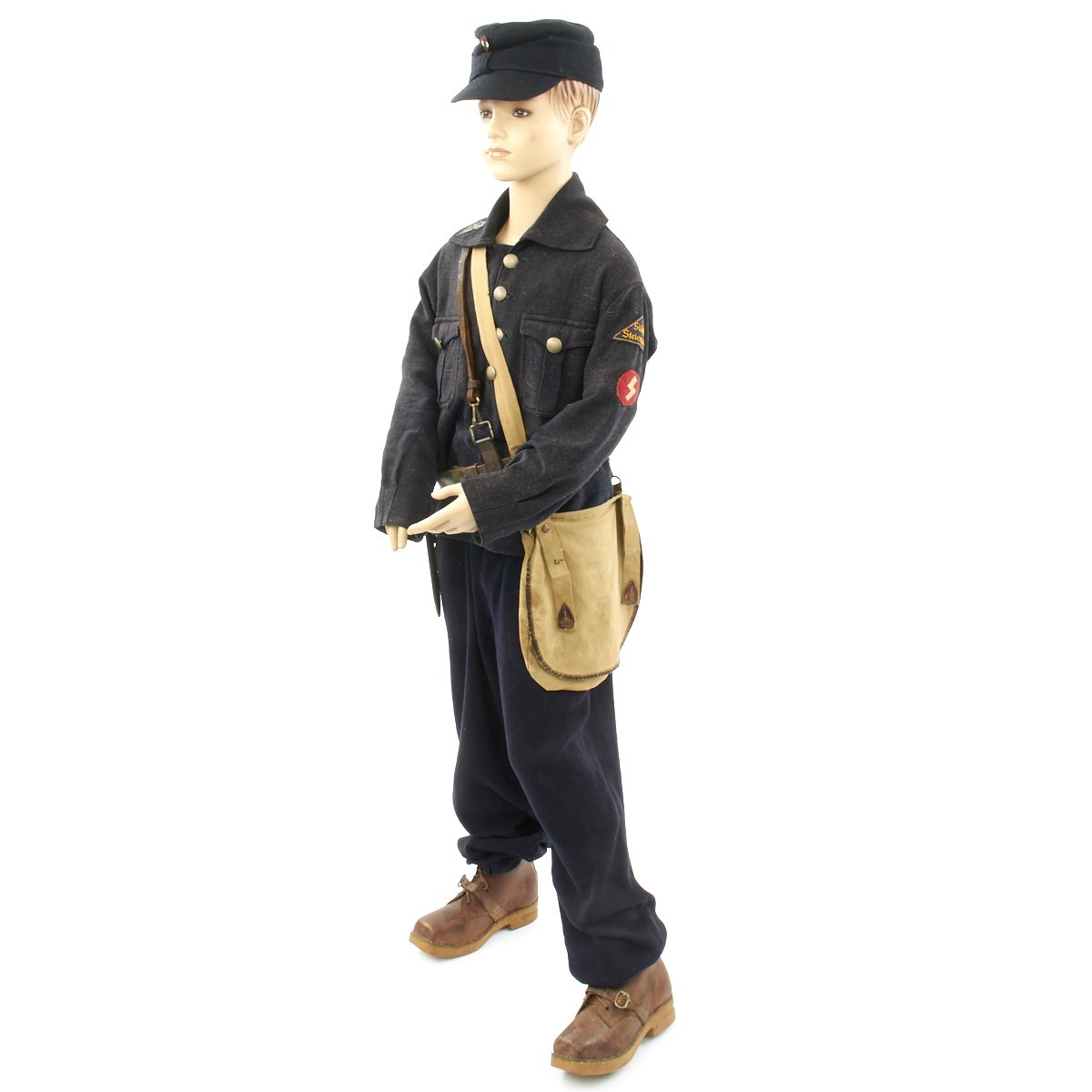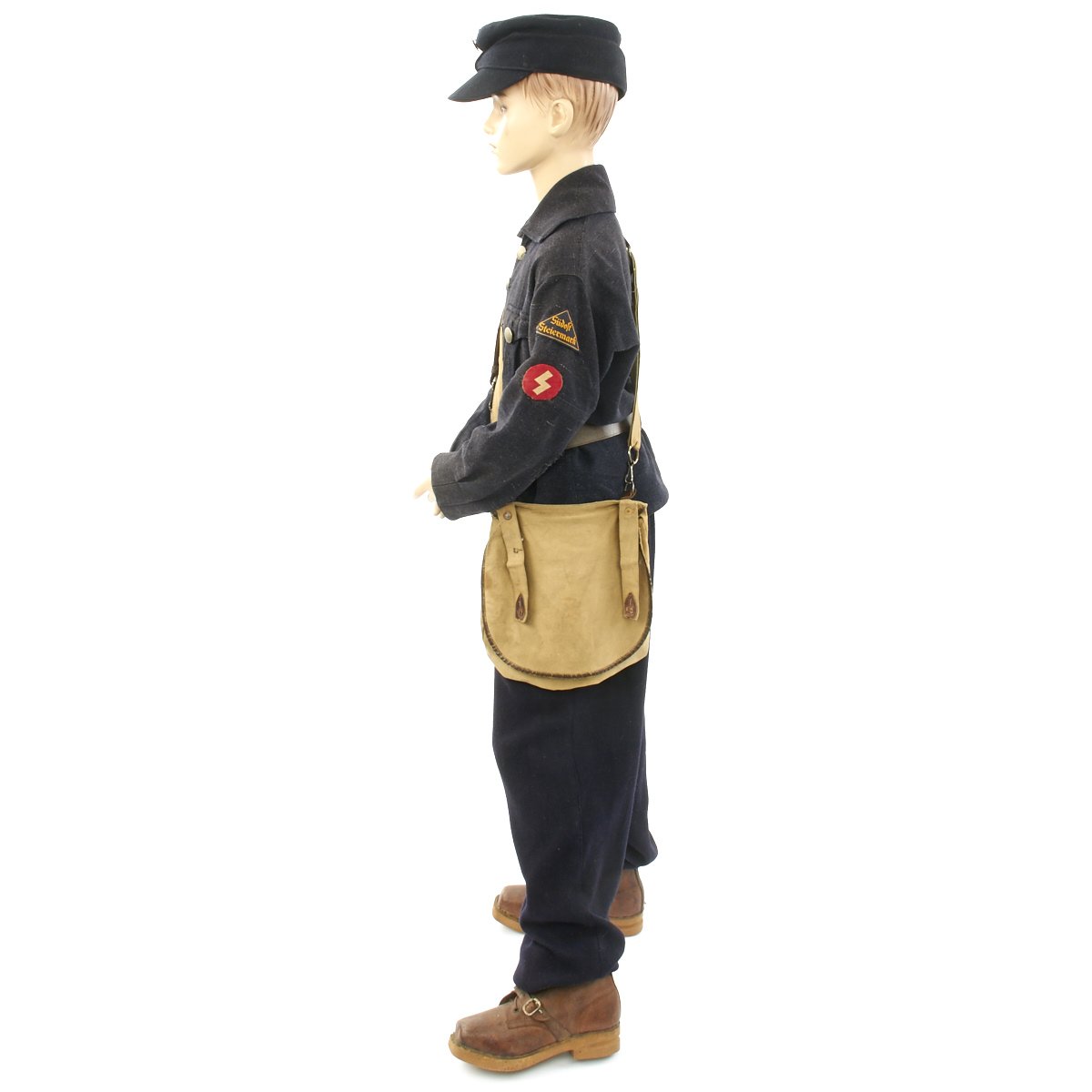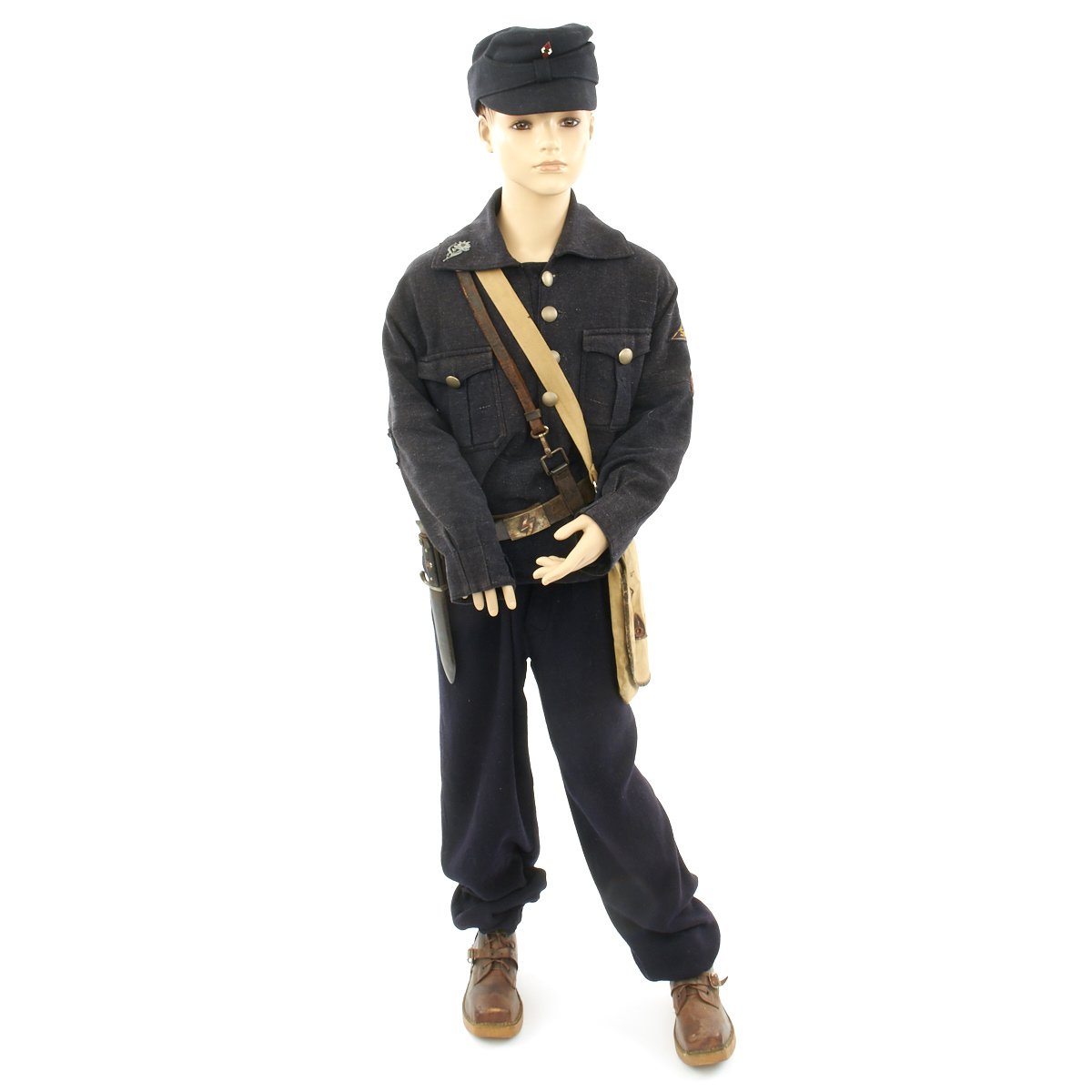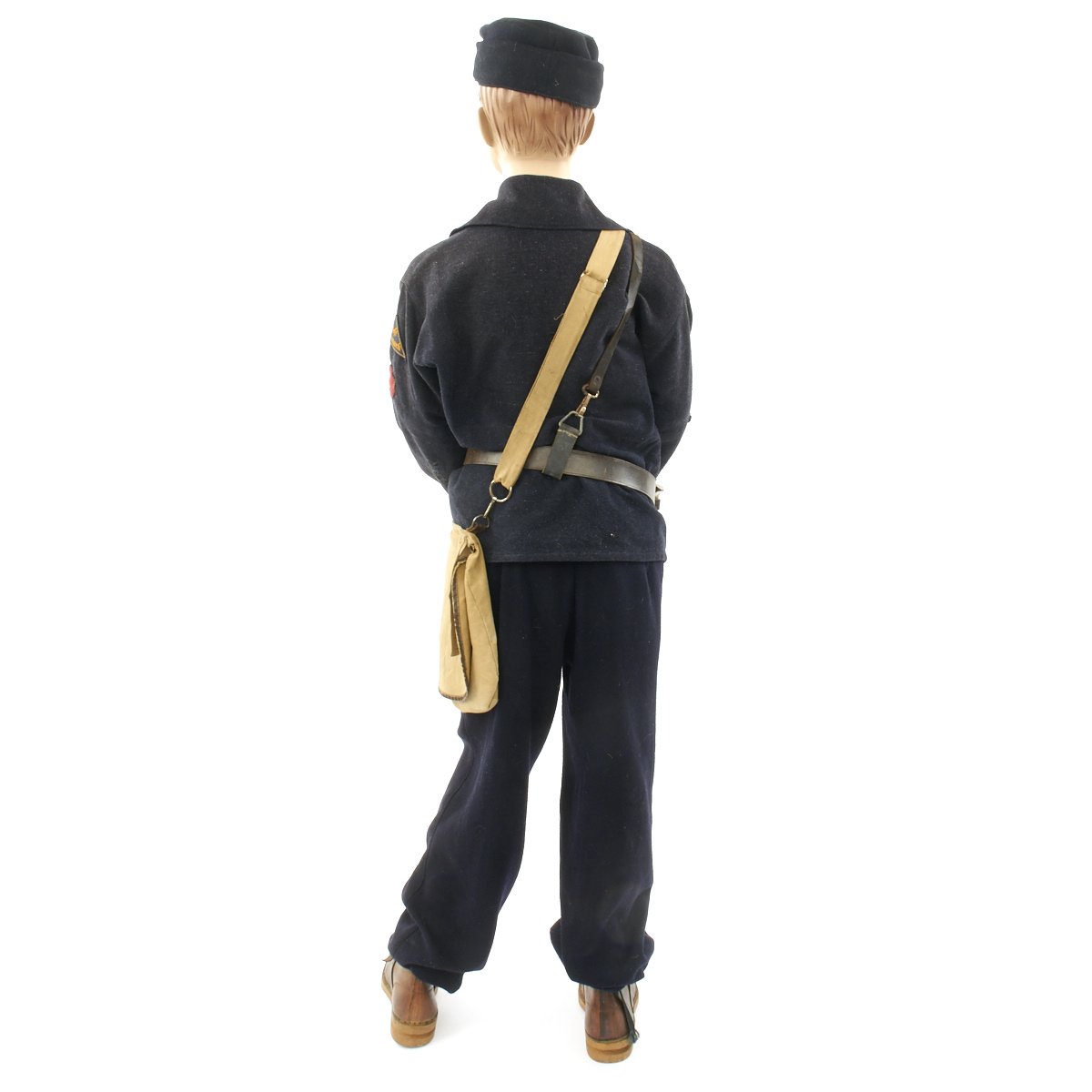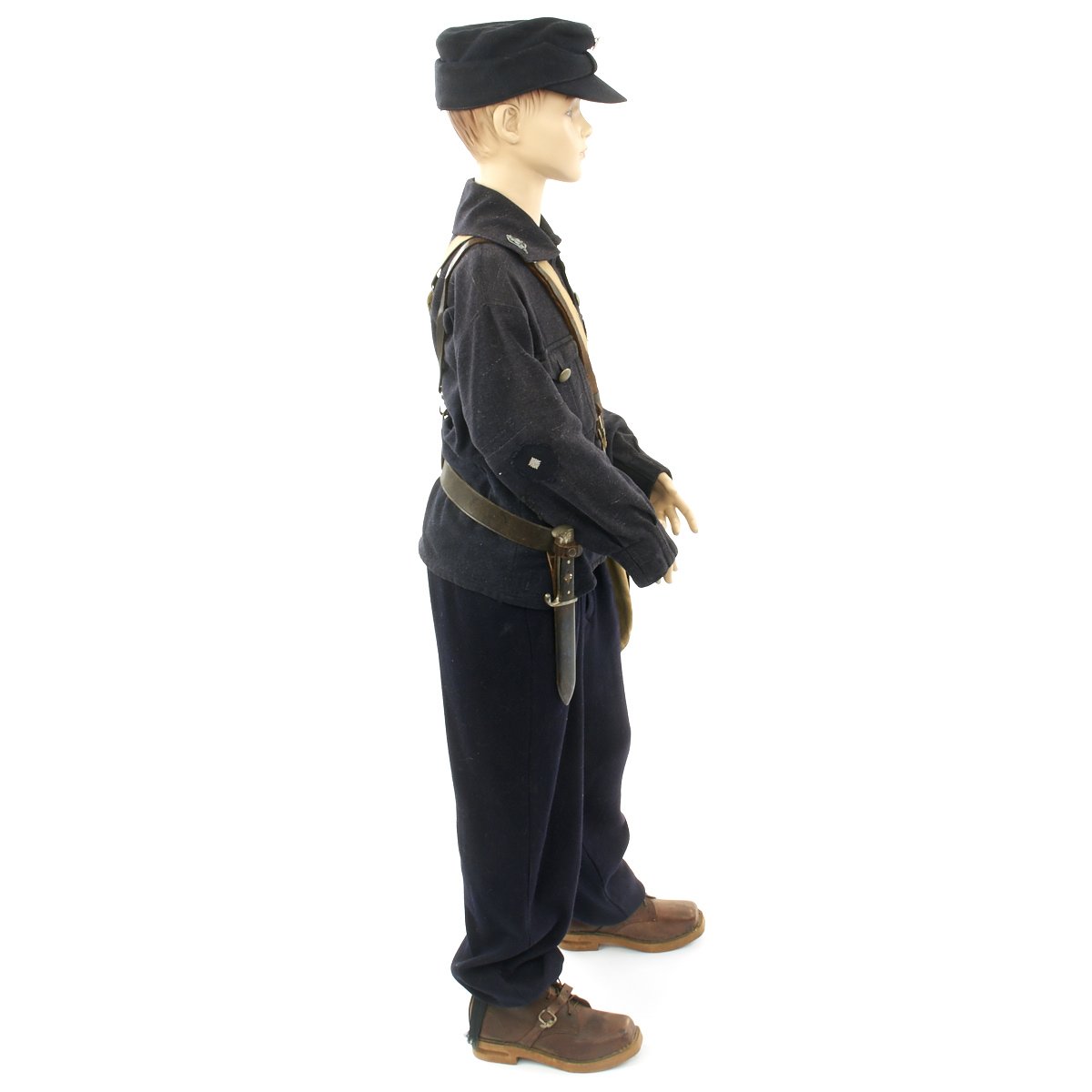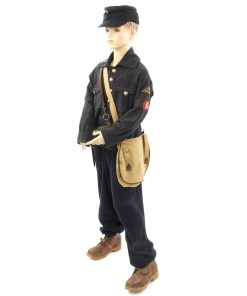Original German WWII HJ Südost Steiermark District Complete Uniform with Child Manikin Original Items
$ 1.595,00 $ 398,75
Original Item: One-of-a-kind. This is a Pre-WWII genuine HJ uniform in dark blue wool for the Südoststeiermark District which is located in southeastern Austria. It is offered in excellent condition and consists of the following pieces.
– Tunic with Südost Steiermark cloth insignia triangle, DJ Sigrune Deutsche Jungvolk – German Youth sleeve patch both on left sleeve. On right collar is a metal edelweiss insignia stitched on as if it were a collar tab. Aluminum Pebble Grain buttons with maker marks on the reverse for Overhoff & Cie.
– Correct matched dark blue Wool trousers.
– HJ Blue Winter M43 Wool Cap. This is an extremely attractive example of the hard to find HJ winter cap. This one was definitely worn and used, giving it a lot of character. It’s made out of a dark blue wool material, with a distinct and visible weave. Features an enamel HJ insignia pin back badge to front. The exterior of this HJ winter cap shows nap wear and some inset dust and soiling from use. The cap retains a great shape even after all these years. The interior lining fabric is a thin rayon, which remains mostly clean, showing normal wear. There is a faded ink manufactures stamp. This HJ winter cap has a great look, as if it was just removed from the head of a HJ in Berlin in 1945. This is a very evocative and impressive artifact.
– Black leather cross belt with DJ Sigrune Deutsche Jungvolk – German Youth belt buckle.
– Puma made HJ Dagger in good condition with some damage to the enamel HJ emblem.
– Brown leather mountain boots.
– Blue necktie.
– Bread Bag.
– Child size manikin that stands nearly 5′ tall.
The first NSDAP youth organization was created in Germany in 1922. In 1926, this organization took on the name “jugend” (HJ) and by 1930, it had over 25,000 members. From 1933 to 1945, the HJ was the only official youth organization in Germany. The HJ was for boys aged 14 to 18, and also included the “Deutsche Jungvolk” for boys aged 10 to 14, and the “Bund deutsche Mädel” for German girls. This was primarily a paramilitary organization. Members learned military skills such as drill and marching, and were arranged in units with a command structure similar to that of the military. These units were subject to political lectures and other types of indoctrination using NSDAP propaganda. By December of 1936, the jugend had over 5 million members. During WWII, The HJ assisted the German postal service and the Reich national railways, among other tasks. By the end of the war, HJ members were being deployed in combat as anti-aircraft gunners attached as auxiliaries to the Luftwaffe, and as members of the Volkssturm militia units. HJ personnel had a wide variety of uniforms and headgear, including tan summer uniforms, wool winter uniforms, and specialized clothing for sports competitions or special units. These uniforms were worn with a wide variety of different insignia which designated specific functions and units. Headgear ranged from simple field caps and ski caps, to specialized equipment. HJ members were also eligible to earn a range of awards. At the end of the war, the jugend was disbanded, and later banned by the German criminal code.
For many countries, the garments worn by youth groups are fairly standard because the youth movements have been dominated by a single or small number of youth groups. With Germany this is a little different. Certainly therec are four groups which have dominated German youth groups (Wandervogel, Scouting, HJ, and the Young Pioneers–East Germany). While these groups were dominant, the German Youth movement, especially during the Weimar Republic was very large and diverse. Unfortunately wedo not have a lot of information on many of the different youth groups that were active during this period. They were supressed after the NSDAP seized power (1933), although Catholic groups were allowed to operate a few years longer. The first important German youth group had a uniform, but it was more like a agreement on utilitarian garments. As far as we can tell, the rather loosely organized organization did not give great attention to a uniform and we do not see Wandervogel images with the boys all outfitted in matching uniforms. Instead easy manyinence short pants (especially corduroy shorts), dark shirts, a waterproof jacket, and hob-nailed boots were indispensable. This was in effect a uniform, but was not the para-military uniform adopted by the Scouts or later by the HJ and Pioneers. Some of the available images of the Wandervogel seem to show the boys without uniforms, although it is not always easy to tell. The Boy Scouts were less important in Germany than other European countries, but the military-inspiref Scout uniform had enormous importance on the uniforms of other German youth groups. You can see Scout items like neckerchiefs, short pants, and knee socks echoed in the uniforms of the other groups, especially the HJ and to a lesser extent the Young Pioneers. The various smaller groups also added some garments to the ones used by the country’s youth groups.
Group Uniforms
For many countries, the garments worn by youth groups are fairly standard because the youth movements have been dominated by a single or small number of youth groups. With Germany this is a little different. Certainly therec are four groups which have dominated German youth groups (Wandervogel, Scouting, HJ, and the Young Pioneers–East Germany). While these groups were dominant, the German Youth movement, especially during the Weimar Republic was very large and diverse. Unfortunately wedo not have a lot of information on many of the different youth groups that were active during this period. They were supressed after the NSDAP seized power (1933), although Catholic groups were allowed to operate a few years longer. The first important German youth group had a uniform, but it was more like a agreement on utilitarian garments. As far as we can tell, the rather loosely organized organization did not give great attention to a uniform and we do not see Wandervogel images with the boys all outfitted in matching uniforms. Instead easy manyinence short pants (especially corduroy shorts), dark shirts, a waterproof jacket, and hob-nailed boots were indispensable. This was in effect a uniform, but was not the para-military uniform adopted by the Scouts or later by the HJ and Pioneers. Some of the available images of the Wandervogel seem to show the boys without uniforms, although it is not always easy to tell. The Boy Scouts were less important in Germany than other European countries, but the military-inspiref Scout uniform had enormous importance on the uniforms of other German youth groups. You can see Scout items like neckerchiefs, short pants, and knee socks echoed in the uniforms of the other groups, especially the HJ and to a lesser extent the Young Pioneers. The various smaller groups also added some garments to the ones used by the country’s youth groups.
Specific Garments
We see German boys wearing aide range of uniform items. Only the Boys Scouts wore the Baden-Powell lrmon-squeezer cap, but we see varioys groups wearing military-styled peaked caps, campaign caps, berets, and other styles. One especially popular cap was the Schirmmütze, a military style that was used as a winter cap for the HJ. Many groups adopted the Neckerchief introduced by the Boy Scouts. Both the HJ and Young Pioneers adopted neckerchiefs as well many smaller groups. We notice a range of different shirt styles. Military styles with pockers were very popular. Many groups had short pants uniform, primarily because they were seen as suitable for outdoor activities. Also because they were standard boys’ wear at the time. Most groups until after orld war II wore knee socks with short pants. Knicker-like ski pants were also worn and after World War II we begin to see more long pants in the post-War era. We also see many boys wearing heavy, boot-like footwear suitabke for outdoor activities. One destinctive German youth group item was the Jungenschaftsjacke introduced by dj 1.11. We also note a range of popular accessories, especially belt buckles and knives.
Fast Shipping with Professional Packaging
Thanks to our longstanding association with UPS FedEx DHL, and other major international carriers, we are able to provide a range of shipping options. Our warehouse staff is expertly trained and will wrap your products according to our exact and precise specifications. Prior to shipping, your goods will be thoroughly examined and securely secured. We ship to thousands clients each day across multiple countries. This shows how we're dedicated to be the largest retailer on the internet. Warehouses and distribution centres can be located throughout Europe as well as the USA.
Note: Orders with more than one item will be assigned a processing date depending on the item.
Before shipping before shipping, we'll conduct a thorough inspection of the items you have ordered. Today, the majority of orders will be delivered within 48 hours. The delivery time will be between 3-7 days.
Returns
The stock is dynamic and we cannot completely manage it because multiple stakeholders are involved, including our factory and warehouse. So the actual stock may alter at any time. It's possible that you may not receive your order once the order has been made.
Our policy is valid for a period of 30 days. If you don't receive the product within 30 days, we are not able to issue a refund or an exchange.
You can only return an item if it is unused and in the same state as the day you received it. You must have the item in its original packaging.
Related products
Uncategorized
Uncategorized
Band of Brothers ORIGINAL GERMAN WWII Le. F.H. 18 10.5cm ARTILLERY PIECE Original Items
Uncategorized
Australian WWII Owen MK1 Machine Carbine SMG Custom Fabricated Replica with Sling Original Items
Uncategorized
Uncategorized
Uncategorized
Uncategorized
Uncategorized
Uncategorized
Uncategorized
Uncategorized
Armoured Fighting Vehicles of the World: AFVs of World War One (Hardcover Book) New Made Items
Uncategorized
Uncategorized
Uncategorized
Uncategorized
Uncategorized
Uncategorized
